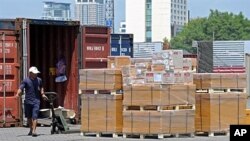The contraction in global trade in the past year has led many governments in Asia, including Thailand, to take a fresh look at an economic model that has led growth over recent decades. Economists and business analysts say Asia is shifting focus to regional trade to cut its dependence on the United States and European markets.
Asia's economic fortunes over the past several decades rested on exports, especially of manufactured consumer goods, electronics and textiles.
The strategy has raised living standards and reduced poverty from Japan to Indonesia.
But this year, the World Trade Organization says global trade has contracted at rates not seen in almost 80 years. Export earnings among the world's poorest countries sank by over 40 percent, erasing millions of jobs, as the financial crisis that started in the United States swept across the globe.
The Thai economy is a leading example of the export model. The United States and Europe account for more than a quarter of its exports; but this year shipments to those markets are down about 17 percent.
Kiat Sittheeamorn, president of the Thailand Trade Representative Office, says the global downturn led many Asian governments to question their dependence on exports.
"There are lots of talks about rebalancing growth, a new growth model," Kiat siad. "The crisis has shown to us that being totally dependent on exports - it can pose problems and some fragility to the economy."
Kiat says governments should pay more attention at promoting local technology and skills to add value to manufactured goods.
Thailand's central bank, the Bank of Thailand, recently said that from 1985 to 2007 the proportion of exports to the country's gross domestic product increased from 25 percent to 70 percent.
Its top exports include textiles, footwear, fishery products, rice, rubber, jewelry, automobiles, computers and electrical appliances.
The United States buys more than 10 percent of Thai exports and is the country's leading trading partner. Its key Asian markets are Japan, China, and Singapore.
Ravi Ratnayake is an economist and director at United Nations Economic and Social Commission for the Asia Pacific. He says the slump has highlighted the country's vulnerability to sharp swings in global trade.
"The region is too much dependent on external markets like the U.S.A. and Europe and without giving attention to domestic demand as well as regional demand," Ratnayake siad. "So what we are saying is that we need to have a balance from sources of growth. If the region does not depend so much on external markets we are saying the impact of the crisis on the region could have been minimized."
Over recent years Thailand has opened new markets through regional free trade agreements. These include deals with India, Bangladesh and Sri Lanka, Australia and New Zealand, and within Southeast Asia.
UNESCAP economist Shamika Sirimanne says the trade deals make a difference.
"They are diversifying away from the European Union and U.S. markets toward regional markets," Sirimanne siad. "There's a lot of intentions, not just Thailand, but also across the region to diversify. They have seen the repercussions of being dependent on big markets and then being burned. But let's see how we move forward how much can be realized."
Sirimanne says reforms are needed to speed regional trade, such as cutting bureaucracy.
"With the neighboring countries there's a lot more forms to be filled, lot more barriers to be jumped just to trade across borders," Sirimanne siad. "These internal barriers need to be lifted if you need to rely more and more on the region for your exports to grow.
Thailand's automobile sector exports to 190 countries, but sales shrank by up to 40 percent over the past year.
Vallop Tiasiri, president of Thailand's Automotive Industry Institute, says the industry remains well placed to benefits from a shift toward Asia.
"We are the alternative production hub in this region. So we still keep competitiveness in Asia. … There are only five places in Asia with a production capacity of more than one million (units) a year," Vallop siad.
Other business analysts say there is too little debate in looking to ways to ensure stable growth.
Jacques-Chai Chomphongdi is an academic and member of group Focus on the Global South, which has been examining an alternative model for growth, with more focus on the domestic economy.
"We have been trying to promote a more diverse model of development beyond the export oriented one," Chomphongdi siad. "And using the case of Thailand it has been going in the direction for the last several decades. It shows many dangerous areas that can occur by relying on external factors as the main engine of economic growth."
Chomphongdi says he wants to see governments be more courageous in presenting alternative models of growth.
The Bank of Thailand says the existing model will continue to drive the economy. It says the small domestic market will not replace exports as the "superior engine" of growth for several years.
Thailand's exports are expected to rise by 15 percent next year. But attention will be on how much trade shifts away from the U.S. and Europe toward Asia.




